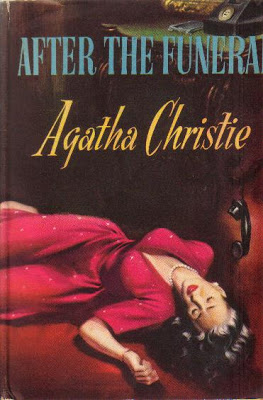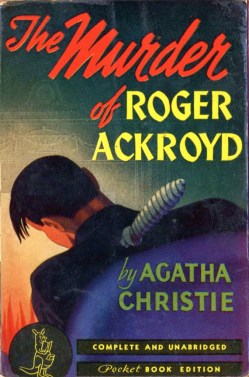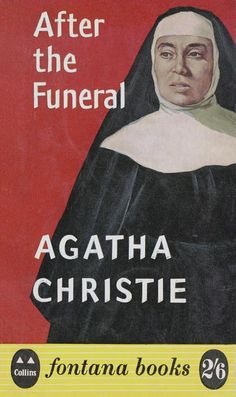The last great Hercule Poirot novel opens, appropriately enough, with a funeral.
It’s 1953. Agatha Christie will continue to write for twenty more years, and twenty two more novels will be published. Many of them will be grand stories. Miss Marple will come into her own with seven of her twelve novels appearing after this one. A few notable stand-alones will appear: Ordeal by Innocence, The Pale Horse, and Endless Night. And although the late 60’s and early 70’s will reveal a lamentable decrease in her writing powers, Christie has wisely planned ahead for delivering the coup de grace by writing the final Poirot and Marple novels – Curtain and Sleeping Murder – in the 1940’s at the height of her powers.
So let us savor for a moment the last great Hercule Poirot novel, After the Funeral.

This is my last book post but one before I head out to New York on Tuesday, where I will focus this blog on theatre. I thought I would thus enjoy turning my attentions to my favorite Christie novel. We all have our favorites, (which tend to fluctuate with the time of day!), and my analysis of of a favorite could be dismissed as heavily biased. If one of you wants to sing praises of Passenger to Frankfurt, be my guest; I will listen. In regards to After the Funeral, however, bear with me here, as I think I can convince you of this novel’s greatness.

I like to divide Christie’s career into three sections. The first, 1920 to 1933, is when she really honed her craft. There is plenty of pleasure to be had from this group of stories, as well as a few classics, like Roger Ackroyd. But if Christie had stopped writing at this point and headed off to be an archeologist’s wife, I have a feeling that we would not be talking much about her these days.
1934 to 1953 marks the Golden Age of Christie’s work. It starts with a run of her greatest puzzles, including Murder on the Orient Express, Death on the Nile and The A.B.C. Murders. With her classic And Then There Were None, Christie sacrifices a little bit of the attention to puzzle (but none of her talent for misdirection) and creates richer characters, more plot experimentation, and a sense of maturity in her writing.
After the Funeral is the finale of this period. Later in 1953, Christie will produce A Pocketful of Rye, a delightful Miss Marple mystery but one where the characters revert to arch types and the misdirection becomes more simplistic and less fair play. With few exceptions, that’s how things will continue until the last few, awful novels. There’s plenty of pleasure still to be had, believe me, but in my estimation, Funeral is the last great Christie novel, certainly the last featuring Poirot.

It begins, as I mentioned, with a funeral, or rather the aftermath of the funeral of Richard Abernethie, who made his fortune in corn plasters and who has, rather suddenly, died. At the start of the novel, Lanscombe, the elderly butler, is “mov(ing) totteringly from room to room,” getting the house ready for the relations to return for the wake. Lanscombe in one of the great Christie butlers, loyal to a fault both to his master, to Enderby Hall, and to a dying mode of British life:
“Lanscombe’s mind went ranging back to a time that stood out clearly and distinctly – much more distinctly than the last twenty years of so, which were all blurred and confused and he couldn’t really remember who had come and gone or indeed what they looked like. But he could remember the old days well enough.”
Through Lanscombe, we learn the history of the Abernethie family and are introduced to the relations coming back from the funeral. Christie also takes a little time to reflect on the changing world, of a grand family home destined to be sold and cut up into apartments or offices, of a fading servant class whose older members are beside themselves about what to do next.

As the family arrives, we see that they are more subtly drawn than your typical group of greedy relations. Think of Hercule Poirot’s Christmas from the 30’s or the later 4:50 From Paddington, where the sons are divided into the Sensualist, the Aesthetic one, the stiff Success Story, and the angry lad. (Nothing wrong with this: Dostoevsky did the same thing in The Brothers Karamazov!) The two generations of Abernethies don’t quite fit into prescribed “types.” What’s more, Christie takes some care to draw them so we understand why this family was never close. Four of Richard’s siblings have pre-deceased him, and his brother Timothy has begged off, either due to ill health or to ill feeling over Richard’s comparative success and ease in life. Only Cora, the youngest sister, is in attendance. Cora hasn’t been seen by anybody for twenty years, due to her having married a lascivious half-French painter of low talent and dubious morals. Cora has certain consistent habits and mannerisms, the most annoying of which is to blurt out whatever she sees fit at the least opportune moment. So when she announces at the gathering that she assumed everyone knew that Richard Abernethie was murdered, she rattles everyone’s nerves but is dismissed out of hand. “That aunt of yours must be completely bats!” mutters an in-law to his wife.
It becomes harder to dismiss Cora when she is found brutally murdered in her home the next day. Did she know more about Richard’s death than she had announced? Does her companion, the twittering Miss Gilchrist, know more than she’s telling? And what’s with all the nuns popping up, first at Enderby Hall and then at Cora’s home? Are they all really nuns?

After Cora’s murder, the novel is well divided between the investigation of the connection between the siblings’ deaths by the family solicitor, Mr. Enderby, who calls in Hercule Poirot, and the subsequent actions of the family members. Christie draws a keen picture of the younger generation’s pull away from staid tradition to pursue their own ambitions while the older generation plays by family rules found in mysteries of the 1930’s where one kept one’s scandals well hidden. I’m particularly fond of the women in this novel: the saintly Helen, the put upon Maude, ambitious niece Susan, the outwardly vacuous Rosamund, “the lovely nitwit,” who as the novel progresses more and more resembles her dead aunt Cora, and the eager to please Miss Gilchrist. And when Uncle Timothy finally appears, the selfish, hypochondriacal old coot nearly steals the show.
“It all began with that damned Labour Government. Sending the whole country to blazes. And the Government we’ve got now is no better. Mealy-mouthed, milk-and-water socialists! Look at the state we’re in! can’t get a decent gardener, can’t get servants – poor Maude here has to work herself to a shadow messing about in the kitchen (by the way, I think a custard pudding would go well with the sole tonight, my dear – and perhaps a little clear soup first?) I’ve got to keep my strength up – Doctor Barton said so – let me see, where was I?”
What other pleasures are to be had here? Well, there’s Poirot’s decision in the second half of the novel to go undercover as M. Pontarlier of UNARCO, an organization dedicated to refugee housing and welfare. Poirot has long used the ruse of playing “the dumb foreigner,” figuring that people will talk more freely in front of a man they barely notice. Yet, when he reveals to Lanscombe his (fictitious) plans to purchase Enderby Hall in order to shelter foreigners, the butler, in a moment of great eloquence, to my opinion puts Poirot in his place:
“You’ll understand, sir, that it’s sad for me to think that this won’t be a private dwelling house any longer. But I know how things are nowadays. None of the family could afford to live here – and I don’t think the young ladies and gentlemen would even want to do so. Domestic help is too difficult to obtain these days, and even if obtained is expensive and unsatisfactory . . . If it has to be an – an institution of some kind, I’ll be glad to think that it’s the kind you’re mentioning. We were Spared in This Country, sir, owing to our Navy and Air Force and our brave young men and being fortunate enough to be an island. If Hitler had landed here we’d all have turned out and given him short shrift. My sight isn’t good enough for shooting, but I could have used a pitchfork, sir, and I intended to do so if necessary. We’ve always welcomed the unfortunate in this country, sir, it’s been our pride. We shall continue to do so.”
I’d like a few modern politicians I can think of to show even a tenth of Lanscombe’s compassion.

Then there’s the mystery itself, heavily and fairly clued, proving perhaps for the last time in her canon the extent of Christie’s skills at misdirection. How I would love to discuss some of these tricks in detail, but I will resist. As for the solution . . . Author Sophie Hannah wrote a forward for a special re-issue of this novel and spoke (a bit too spoiler-y, if you ask me) about the charms of this mystery’s denouement. I won’t say a thing about it. I will finish with this, however. I recently was asked to name my favorite Poirot novel. In true fan fashion, I named three: Death on the Nile, Five Little Pigs, and this one. Now, these are three very different reading experiences. Nile is a pure puzzler, crammed with suspects and clues, with five dead bodies by novel’s end. Pigs is almost a novel with murder, marked by deeper characterization and the whole aura that accompanies a mystery told in retrospect.
Funeral is kind of a blend of both these experiences, a complex puzzler that also, more than any other Poirot story, delves into the changing of the social guard of England. Plus, it’s the funniest story of the three by far. What this trio of novels does share is that they all satisfy on the level of mystery and they all provide an emotional punch, of varying levels and effect, at the end. I do think Nile and Pigs get a greater share of attention – and they deserve the attention they get – but I urge anyone who hasn’t read After the Funeral to do so. You won’t be disappointed. It is a great Poirot novel.
It is my favorite.
I love your choice of three favourite novels highlighting different experiences. I know some who avoid Christie thinking everything is from the same template, but it is not true.
I also love how you avoided spoiling the novel. Not everyone is so considerate.
LikeLike
Thanks, Patricia. I absolutely agree with you that Christie did not apply one pattern to her work. Even a cursory examination of her books will show that.
I’ll admit that I’m not above spoilers sometimes, but I provide key warnings. I would NEVER spoil After the Funeral for anybody! It’s just too good! 🙂
LikeLike
Fascinating review! I’m not sure I’ve read this one, so I really appreciate how you didn’t spoil the ending! It’s exciting to think there is an Agatha Christie novel still left where I don’t know who the killer is (usually, I’ve seen a film adaptation). 🙂
It was interesting to read your take on the different segments of her career – when she was honing her craft, when she hit her stride. When I went through many of her books years ago, I did pay attention to which years each book had been written in, so they are all jumbled. It will be interesting to look for that.
Thanks so much for joining in the celebration of Agatha Christie!
LikeLike
Christina, Thank you for your kind comments, but most of all thanks for providing this forum to help celebrate my favorite mystery author! 🙂
LikeLiked by 1 person
Pingback: God Save the ‘Queen of Crime’ – the Agatha Christie Blogathon Is Here! – Little Bits of Classics
I can only agree with you – Agatha Christie was much more than a mystery writer. She wrote about people and their feelings and about the change of times, but above all she always held dear the value of life! That’s one of the reasons I love her. On top of the book, I really loved the adaptation of After the Funeral with David Suchet. Have you seen it yet? It’s one of my favourite episodes, it contains everything I love Agatha Christie for!
Thanks for joining our blogathon!
Domi (Little Bits of Classics)
LikeLiked by 1 person
I did see the adaptation, Domi, and I thought it was great, although given the nature of the murder plot, this is a tough one to film.
LikeLiked by 1 person
Yes, that is quite right 🙂
LikeLike
Great post about a great book! Those middle years were superb – no-one else comes close to the sheer variety and quality Agatha Christie turned out during them. One of the things I’ve always loved about her is that the books are not all about the detectives much though we love them. In each one she gives us a whole set of characters and the dynamics amongst them all, and this book is a prime example of that. For me, the Poirot favourites come a little earlier – definitely Death on the Nile, but I’d probably go for Evil Under the Sun and Appointment with Death as my other two. But as you say, it changes depending on which one I last read! 🙂
LikeLike
Frankly, it’s easier for me to point out the Poirots that would NEVER be my favorite – any of the books written after After the Funeral, Dumb Witness from the 30’s, and any of the books written in the 20’s except Ackroyd. (And even these all have their great pleasures.) Otherwise, they are all wonderful each in their own way, and their placement on my list varies. But Nile and Funeral will always be in the top three.
And we haven’t even talked about Miss Marple . . . 🙂
LikeLiked by 1 person
Pingback: Announcing the Agatha Christie Blogathon! | Christina Wehner
The story is great, although I always disliked the greenhouse confrontations and felt some of the characters were bloatage (Susannah’s husband, for example) and the nuns. I could almost smell the paint in the cottage. It was difficult to like any of the characters though, regardless of what a splendid, engaging mystery this is. I remember reading it when it was first published and envisioning Cora tilting her head and speaking her fateful words.
The TV adaptation trimmed and cut artfully, weaving a coherent, believable story that was in essence, true to the original material. In fact, this adaptation demonstrates that Christie can be faithfully adapted even with some changes that improve small-screen storytelling. Also Monica Dolan was brilliant.
I actually liked the story without Greg but did find myself scratching my head about the name/nationality change of Cora’s husband.
LikeLike
Pingback: TAKING TIME TO SAVOR CHRISTIE: Four Decades Worth of Suggestions | ahsweetmysteryblog
Pingback: A CENTURY OF AGATHA CHRISTIE, PART FOUR: The Iffy 50’s | ahsweetmysteryblog
Pingback: IT’S PODCAST TIME AGAIN: After the Funeral | ahsweetmysteryblog
Pingback: IT’S PODCAST TIME AGAIN: After the Funeral – The Controversial Files
I also have a soft spot for this novel – it was my first Agatha Christie. I was 12.
However I didn’t love the Suchet adaptation. By that point I felt he was moving farther and farther away from the source material. ! SPOILER !
And the Susan/George thing wouldn’t have even raised an eyebrow at the time. Elinor Carlisle’s intended was a cousin. First and second cousin marriages were actually encouraged as it kept property in the family.
LikeLiked by 1 person
Plus, in the book Susan was another in the line of enterprising young women who are the smartest person in the room (like Lucy Eyelesbarrow and Sophia Leonides). They all end up with men who excite them but probably aren’t good enough for them. In the Suchet version, we have Susannah, the rowdy religious figure in love with her “bad boy” cousin; they don’t compare. And while I have no real problem with Monica Dolan, this novel cries out for a more deserving adaptation and a better Miss Gilchrist (one of my favorite characters in Christie.)
LikeLike
Pingback: MY AGATHA CHRISTIE INDEX (The Blog-iography!) | Ah Sweet Mystery!